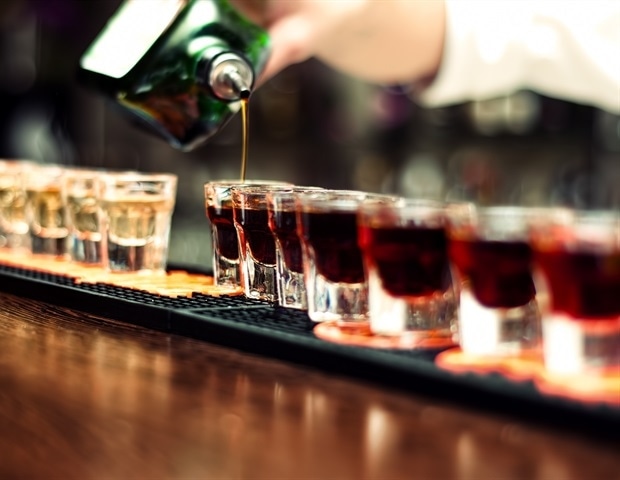The hormone estrogen regulates binge drinking in females, causing them to “pregame” – consume large quantities of alcohol in the first 30 minutes after it’s offered, according to a preclinical study led by scientists at Weill Cornell Medicine. The study establishes–for what is thought to be the first time–that circulating estrogen increases binge alcohol consumption in females and contributes to known sex differences in this behavior.
The findings, published Dec. 30 in the journal Nature Communications, could lead to novel approaches for treating alcohol use disorder.
We know a lot less about what drives alcohol drinking behavior in females because most studies of alcohol use have been done in males.”
Dr. Kristen Pleil, senior author, associate professor of pharmacology
Yet females, too, overindulge and are more susceptible to the negative health effects of alcohol than males.
Recent studies indicate that, during the pandemic lockdown, women increased their heavy alcohol consumption more than men. That behavior has important consequences for women’s health, said Dr. Pleil, “because many studies show this pattern of drinking enhances alcohol’s harmful effects.” Indeed, women had many more alcohol-related hospital visits and complications than men during and since the pandemic.
Peak levels of estrogen associated with increased alcohol consumption
In a 2021 study, Dr. Pleil and her team showed that a specific subpopulation of neurons in a brain region called the bed nucleus of the stria terminalis (BNST) were more excitable in female mice than in males. This enhanced activity correlated with their binge drinking behavior.
But what makes this neural circuit more excitable in females? “Estrogen has such powerful effects on so many behaviors, particularly in females,” Dr. Pleil said. “So, it makes sense that it would also modulate drinking.”
To assess estrogen’s potential involvement, the researchers, including first author Dr. Lia Zallar, who was a graduate student in the Pleil lab at the time of the research, began by monitoring the hormone levels throughout estrous cycle of female mice. Then, they served up the alcohol. They found that when a female has a high level of circulating estrogen, she drinks much more than on days when her estrogen is low.
That enhanced bingeing behavior was reflected in heightened activity in those same neurons in the BNST. “When a female takes her first sip from the bottle containing alcohol, those neurons go crazy,” Dr. Pleil said. “And if she’s in a high-estrogen state, they go even crazier.” That extra boost of neural activity means the mice hit the bottle even harder, particularly within the first 30 minutes after the alcohol was made available, a behavior Dr. Pleil refers to as “front-loading.”
Surprising discovery: Cell-surface receptors allow estrogen to act fast
Although the researchers suspected estrogen would have an effect on drinking, they were surprised by its mechanism of action. This steroid hormone typically regulates behaviors by binding to receptors that then travel to the nucleus, where they alter the activity of specific genes-;a process that could take hours. However, Dr. Pleil and her team realized that something else must be happening when estrogen infused directly into the BNST excited the neurons and triggered binge drinking within minutes.
So, the researchers tested estrogen that had been doctored so it could not enter cells and bind to nuclear receptors-;a feat of chemical engineering performed by Dr. Jacob Geri, assistant professor of pharmacology at Weill Cornell Medicine. They determined that when estrogen promotes bingeing, the hormone is binding to receptors on the neurons’ surface, where it directly modulates cell-cell communication.
“We believe this is the first time that anybody has shown that during a normal estrous cycle, endogenous estrogen made by the ovaries can use such a rapid mechanism to control behavior,” Dr. Pleil said. That rapid action drives the front-loading of alcohol when estrogen is high.
The team identified the estrogen receptor that mediates this effect and determined that it is expressed in the excited BNST neurons and in neurons from other brain regions that excite them. The researchers are now investigating the signaling mechanisms for this effect, and they will also examine whether the same system regulates drinking in males.
“All of the infrastructure is there in males, too: the estrogen receptors and the basic circuit organization,” Dr. Pleil said. The only difference will be the source of the estrogen, which in males without an ovarian source relies on local conversion of testosterone to estrogen in the brain.
Inhibiting the enzyme that synthesizes estrogens could offer a novel treatment for selectively reducing alcohol consumption when hormone levels surge. An FDA-approved version of such an inhibitor is currently used to treat women with estrogen-sensitive cancers.
“Combining this drug with compounds that modulate the downstream effects of the chemicals produced by the BNST neurons could potentially provide a new, targeted approach for treating alcohol use disorder,” Dr. Pleil said.
Source link : News-Medica

